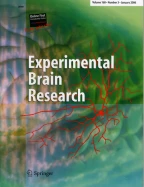Summary
Eye and arm movements to single and double-step target displacements were studied to investigate whether or not the motor systems of the eye and arm share common command signals from the internal representation, which specify a) when a movement is initiated and b) the end position of a movement. The correlation between the time of onset of eye and arm movements was significant for single-step and double-step target displacements into the same direction. However, it was small and not significant for double-step target displacements into opposite directions if the time interval between first and second target displacement was 75 or 100 ms. This indicates that the command signal which specifies when a movement is started is different for both systems. However, the reconstructed signal in the internal representation, which specifies the end position of movements, is rather similar for eye and arm movements which seems to point to a common command signal. This result was corroborated by experiments in which eye and arm were found to jump always to the same target in the condition that two different targets were presented simultaneously.
Similar content being viewed by others
References
Becker W, Jurgens R (1979) An analysis of the saccadic system by means of double step stimuli. Vision Res 19: 967–983
Bizzi E, Kalil RE, Tagliasco V (1971) Eye-head coordination in monkeys: Evidence for centrally patterned organization. Science 173: 452–454
Chun KS, Robinson DA (1978) A model of quick phase generation in the vestibulo-ocular reflex. Biol Cybern 28: 209–221
Findlay JM (1980) The visual stimulus for saccadic eye movements in human observers. Perception 9: 7–21
Findlay JM (1982) Global visual processing for saccadic eyemovements. Vision Res 22: 1033–1045
Georgopoulos AP, Kalaska JF, Massey JT (1981) Spatial trajectories and reaction times of aimed movements: Effects of practice, uncertainty, and change in target location. J Neurophysiol 46: 725–743
Gielen CCAM, Heuvel PJM van den, Denier van der Gon JJ (1983) Modification of muscle activation patterns during fast goal directed arm movements. J Motor Behav (in press)
Gisbergen JAM van, Gielen S, Cox H, Bruijns J, Schaars HK (1981) Relation between stimulus trajectory and metrics of saccades in visual tracking: Implications for models of the saccadic system. In: Fuchs A, Becker W (eds) Progress in oculomotor research. Elsevier, New York, pp 19–27
Herman R, Herman R, Maulucci R (1981) Visually triggered eye-arm movements in man. Exp Brain Res 42: 392–398
Morasso P, Sandini G, Tagliasco V, Zaccaria R (1977) Control strategies in the eye-head coordination system. IEEE Trans Syst Man Cybern 7 (9): 639–651
Prablanc C, Echallier JF, Komilis E, Jeannerod M (1979a) Optimal response of eye and hand motor systems in pointing at a visual target. I. Spatio-temporal characteristics of eye and hand movements and their relationships when varying the amount of visual information. Biol Cybern 35: 113–124
Prablanc C, Echallier JF, Jeannerod M, Komilis E (1979b) Optimal response of eye and hand motor systems in pointing at a visual target. II. Static and dynamic visual cues in the control of hand movement. Biol Cybern 35: 183–187
Roucoux A, Crommelinck M (1980) Eye and head fixation movements: Their coordination and control. In: Stelmach GA, Requin J (eds) Tutorials in motor behavior. North-Holland, Amsterdam, pp 305–314
Soechting JF, Lacquiniti F (1981) Invariant characteristics of a pointing movement. J Neurosci 1: 710–720
Sommerhof G (1974) Logic of the living brain. John Wiley and Sons, London
Wadman WJ, Denier van der Gon JJ, Derksen RJA (1980) Muscle activation patterns for fast goal-directed arm movements. J. Hum. Mov. Studies 6: 19–37
Wheeless L, Boynton RE, Cohen GH (1966) Eye movement responses to step and pulse-step stimuli. J Opt Soc Am 56: 956–960
Author information
Authors and Affiliations
Rights and permissions
About this article
Cite this article
Gielen, C.C.A.M., van den Heuvel, P.J.M. & van Gisbergen, J.A.M. Coordination of fast eye and arm movements in a tracking task. Exp Brain Res 56, 154–161 (1984). https://doi.org/10.1007/BF00237452
Received:
Accepted:
Issue Date:
DOI: https://doi.org/10.1007/BF00237452
